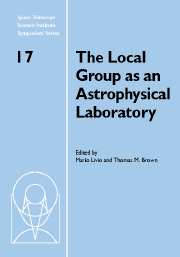 The Local Group as an Astrophysical Laboratory
The Local Group as an Astrophysical Laboratory Book contents
- Frontmatter
- Contents
- Participants
- Preface
- History of the Local Group
- Primordial nucleosynthesis
- Galactic structure
- The Large Magellanic Cloud: Structure and kinematics
- The Local Group as an astrophysical laboratory for massive star feedback
- Hot gas in the Local Group and low-redshift intergalactic medium
- Stages of satellite accretion
- The star formation history in the Andromeda halo
- Bulge populations in the Local Group
- The Local Group as a laboratory for the chemical evolution of galaxies
- Massive stars in the Local Group: Star formation and stellar evolution
- Massive Young Clusters in the Local Group
- Magellanic Cloud planetary nebulae as probes of stellar evolution and populations
- The old globular clusters: Or, life among the ruins
- Chemical evolution models of Local Group galaxies
The Local Group as an astrophysical laboratory for massive star feedback
Published online by Cambridge University Press: 12 May 2010
- Frontmatter
- Contents
- Participants
- Preface
- History of the Local Group
- Primordial nucleosynthesis
- Galactic structure
- The Large Magellanic Cloud: Structure and kinematics
- The Local Group as an astrophysical laboratory for massive star feedback
- Hot gas in the Local Group and low-redshift intergalactic medium
- Stages of satellite accretion
- The star formation history in the Andromeda halo
- Bulge populations in the Local Group
- The Local Group as a laboratory for the chemical evolution of galaxies
- Massive stars in the Local Group: Star formation and stellar evolution
- Massive Young Clusters in the Local Group
- Magellanic Cloud planetary nebulae as probes of stellar evolution and populations
- The old globular clusters: Or, life among the ruins
- Chemical evolution models of Local Group galaxies
Summary
The feedback effects of massive stars on their galactic and intergalactic environments can dominate evolutionary processes in galaxies and affect cosmic structure in the Universe. Only the Local Group offers the spatial resolution to quantitatively study feedback processes on a variety of scales. Lyman continuum radiation from hot, luminous stars ionizes H II regions and is believed to dominate production of the warm component of the interstellar medium (ISM). Some of this radiation apparently escapes from galaxies into the intergalactic environment. Supernovae and strong stellar winds generate shell structures such as supernova remnants, stellar wind bubbles, and superbubbles around OB associations. Hot (106 K) gas is generated within these shells, and is believed to be the origin of the hot component of the ISM. Superbubble activity thus is likely to dominate the ISM structure, kinematics, and phase balance in starforming galaxies. Galactic superwinds in starburst galaxies enable the escape of mass, ionizing radiation, and heavy elements. Although many important issues remain to be resolved, there is little doubt that feedback processes plays a fundamental role in energy cycles on scales ranging from individual stars to cosmic structure. This contribution reviews studies of radiative and mechanical feedback in the Local Group.
Introduction
The Local Group is especially suited as a laboratory for studying the effects of the massive star population on the galactic environment. There are three types of massive star feedback:
(a) Radiative feedback, i.e., ionizing emission, which results in photoionized nebulae and diffuse, warm (104 K) ionized gas;
(b) Mechanical feedback, predominantly from supernovae (SNe), resulting in supernova remnants (SNRs), superbubbles, and galactic superwinds; and
[…]
- Type
- Chapter
- Information
- The Local Group as an Astrophysical LaboratoryProceedings of the Space Telescope Science Institute Symposium, held in Baltimore, Maryland May 5–8, 2003, pp. 72 - 85Publisher: Cambridge University PressPrint publication year: 2006
- 3
- Cited by


